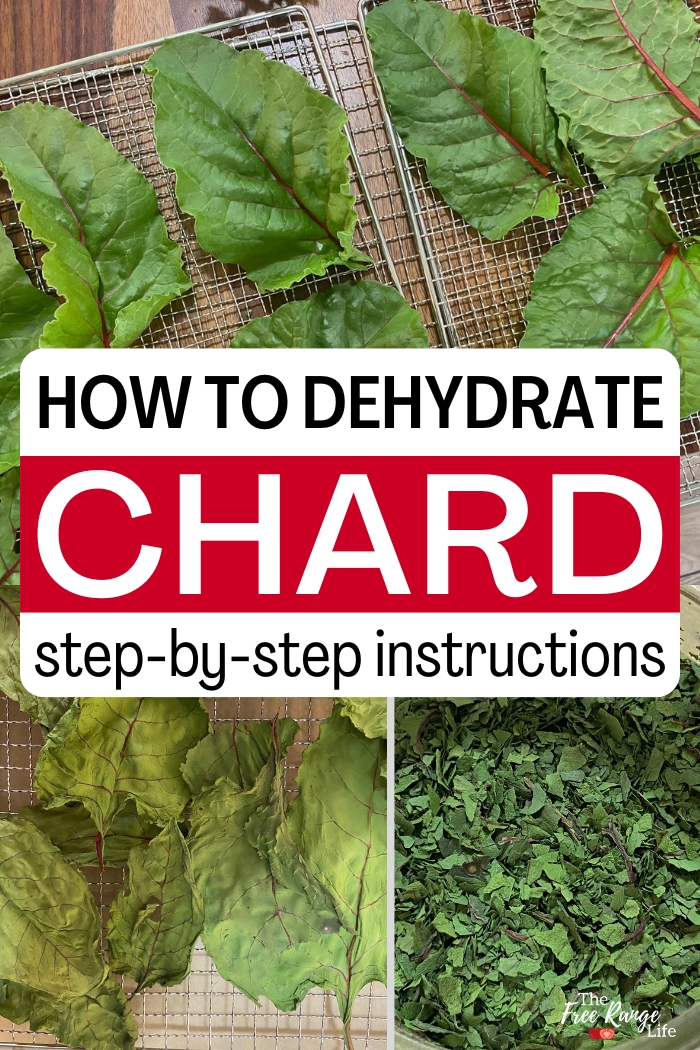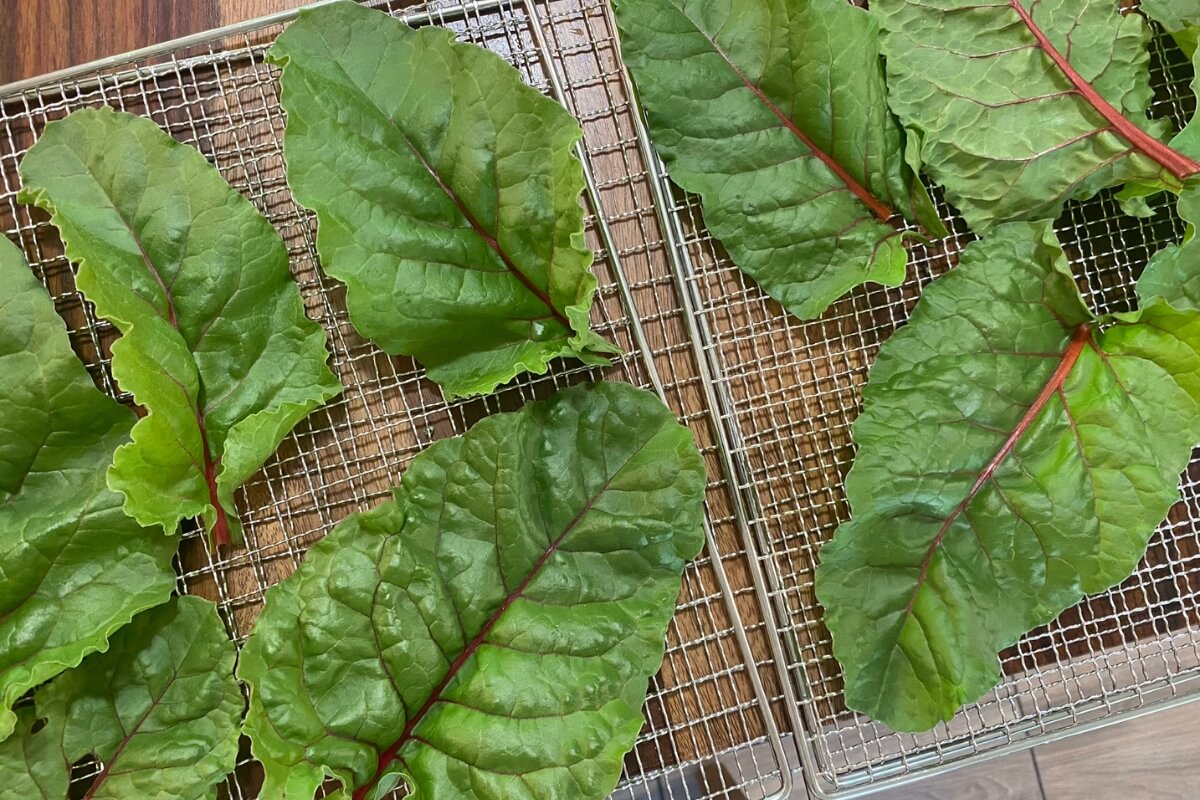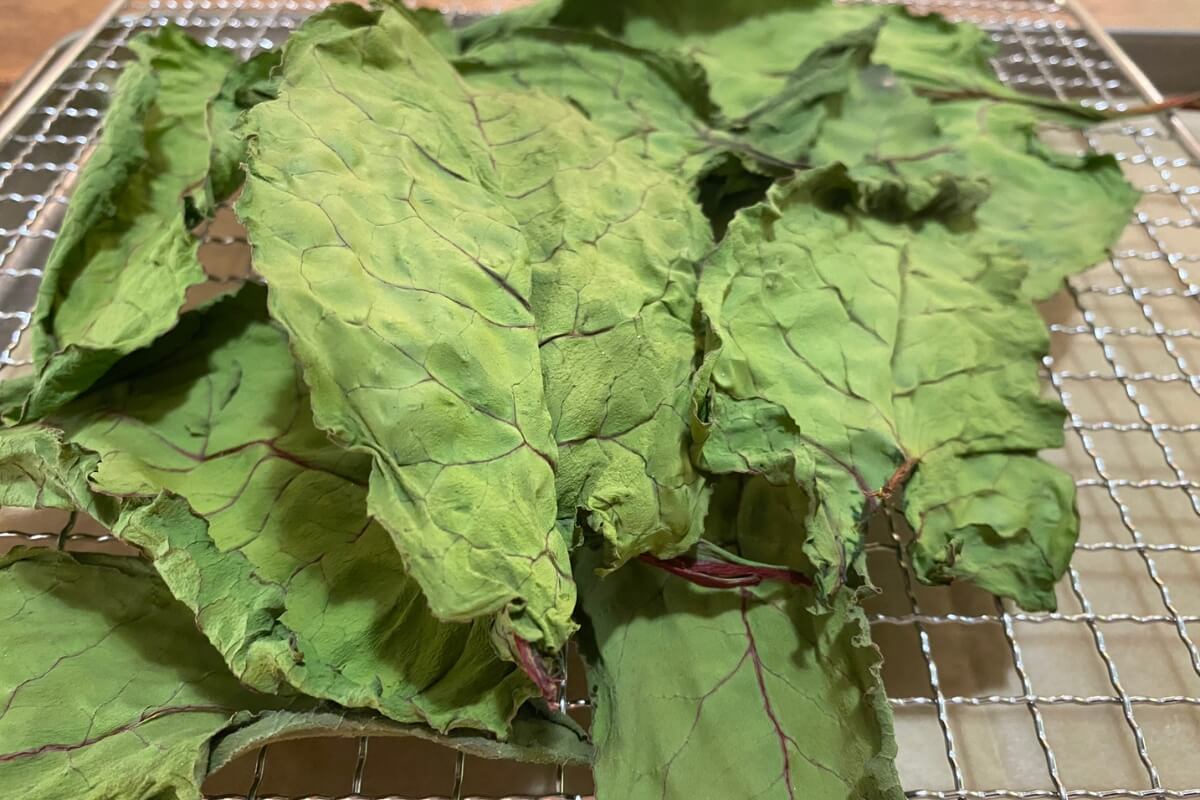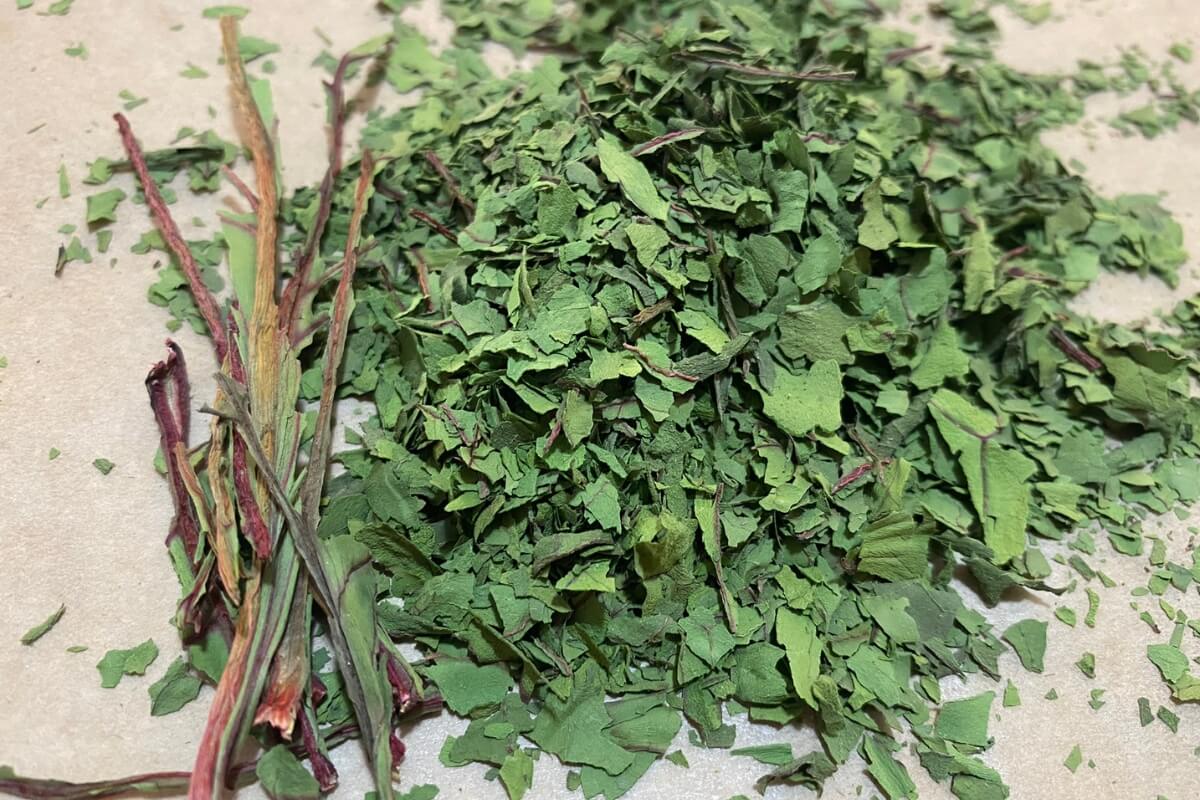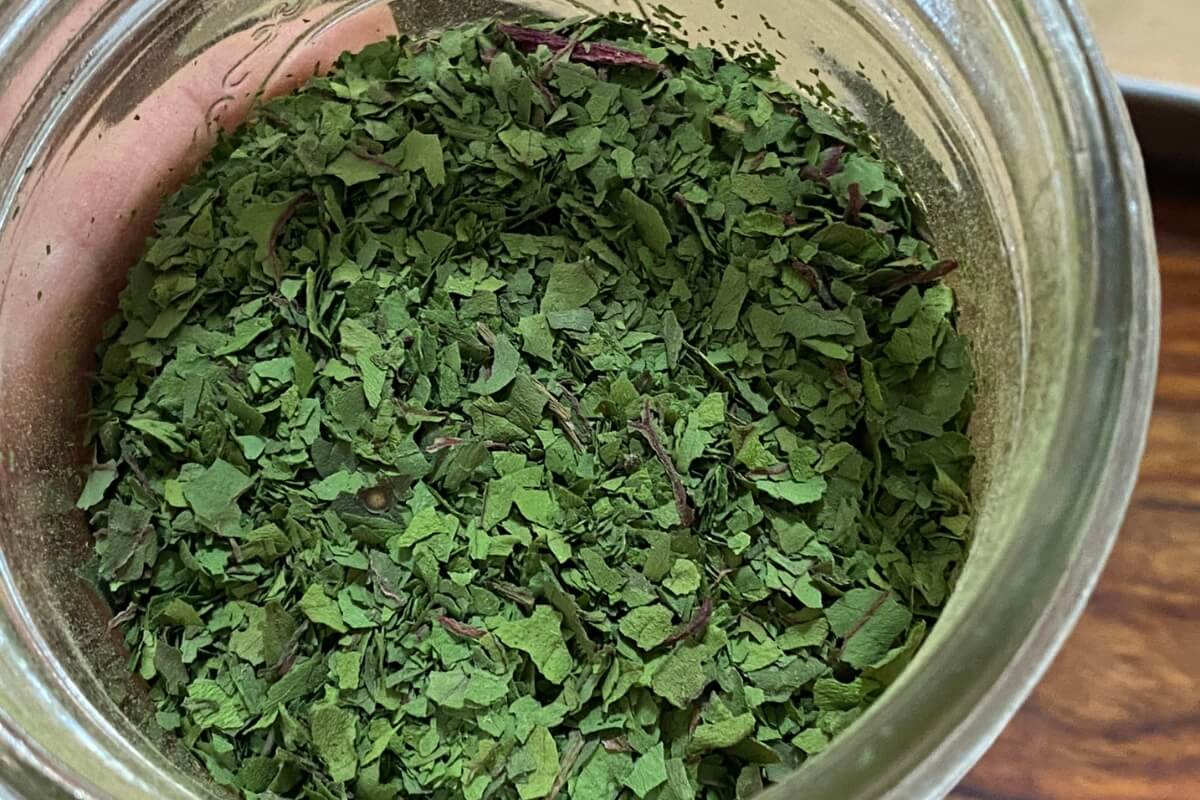Swiss chard, like most greens, is an easy vegetable to dehydrate. It needs almost no prep work and dries very quickly. Learn how to dehydrate Swiss chard (and make Swiss chard powder) using these simple methods!
This versatile vegetable is packed with essential nutrients, making it a nutrient-dense food choice. Swiss chard is an excellent source of vitamins A, C, and K, as well as magnesium, potassium, and iron. Swiss chard is also rich in dietary fiber,so including Swiss chard in your meals can provide a range of essential nutrients, contributing to overall well-being and a healthy lifestyle.
This site contains affiliate links. If you make a purchase using one of these links, I may earn a commission. Please see my disclosure page for more information about cookies collected and our privacy policy.
Swiss chard may not be as popular as other greens like spinach or kale, but it is something all home gardeners should give a try growing. Another bonus for dehydrated Swiss chard- it makes it super easy to hide this nutritious vegetable in other dishes like soups, rice, sauces, dressings, smoothies and more!
There are 3 different ways you can dehydrate Swiss chard at home, so let’s start with my favorite!
How to Dehydrate Swiss Chard in an Electric Dehydrator
An electric dehydrator is my preferred way of drying Swiss chard, and here’s why:
- It keeps the Swiss chard at a controlled temperature, that’s not too high and won’t cook the nutrients out of your vegetables.
- It’s quick! You can dry chard in less than 6 hours (that’s short for drying times!)
- There’s no chance of burning the Swiss chard.
To dry Swiss chard, start by washing and thoroughly drying the chard leaves. I’ll admit that I usually skip this step since my chard comes fresh from my organic garden, but you do you.
A salad spinner really helps get it really dry if you do choose to wash first.
Lay the Swiss chard leaves on your dehydrator trays in a single layer. If you are using very large leaves, you may choose to remove the large center stem first since it will take longer to dry.
Set the temperature for 125-130 degrees Fahrenheit.
The Swiss chard should take 4-7 hours to dry completely, depending on the humidity and conditions in your home.
Make sure the leaves and stems are 100% completely dry before storing to prevent molding and spoilage. Once the Swiss chard is completely dry, turn off the dehydrator and allow the Swiss chard to cool to room temperature before storing.
Don’t have a dehydrator? Check out the 11 Best Electric Dehydrators to help you choose one.
How to Dehydrate Swiss chard in Your Oven
If you don’t have a dehydrator, you can use your oven to dehydrate Swiss chard.
The key to dehydrating Swiss chard in the oven is to use the lowest temperature possible (or 125 degrees Fahrenheit, if yours goes that low). My oven goes to 145 at the lowest if I use the warming function.
If your oven doesn’t go below 200 degrees, you might want to leave the door open a crack to prevent the Swiss chard from getting too hot and burning.
Place the clean Swiss chard leaves on parchment paper lined baking trays in a single layer. Cook in an oven, set on the lowest heat setting, until dry and crispy.
You will need to turn the trays and flip the leaves a couple of times to get an even dry.
Allow to cool completely before storing.
How to Air Dry Swiss chard
You can also air dry or use a solar dehydrator to dry Swiss chard. This way will take much longer, but it is also free and doesn’t require any special equipment.
This isn’t my favorite way of dehydrating since I live in a humid location and things tend to mold before they dry. But if it’s all you have, give it a try!
If you are using large Swiss chard leaves, tie together handfuls of stems. Hang the stems in a place where there is good air flow and low humidity.
If you are dehydrating baby Swiss chard leaves, lay them on screens or trays in a single layer. If you can place them on cooling racks so that they get more air flow, even better!
It might take 2-3 weeks (or more) for your Swiss chard to dry completely, depending on the humidity in your home.
You can also get a hanging, mesh solar dehydrator, to prevent pests or dust from contaminating your Swiss chard while it dries.
Again, be sure your Swiss chard is 100% dry before storing.
How to Store Dry Swiss chard
Once your Swiss chard is completely dry, place it in an air tight, glass container. I prefer mason jars with metal rings/lids since they are air tight and don’t let in any moisture.
I like to crush my leaves before storing, this helps me see that the leaves are completely dry, and it takes up less space in the jar. I crush the leaves and remove the thicker stems.
You can also run the dry Swiss chard through the blender or rub it between your hands to form Swiss chard powder. A blender will make the powder very fine.
I actually mix all of my dried greens-spinach, kale, and chard- together into one jar, so it’s more like dried greens powder.
Store the jar in a cool, dry location that’s not in direct sunlight for maximum shelf life. It should last at least a year if prepared properly.
How to Use Dried Swiss chard
Now that you have lots of dehydrated Swiss chard, what should you do with it?? Well, the sky’s the limit! That’s the best part about dried Swiss chard, you can add it to virtually anything and it’s almost undetectable. It’s the perfect way to get a little more veggies in your (or your kids!) diets.
Here are some of my favorite ways to use dried Swiss chard or Swiss chard powder:
- Add it to your smoothies- add it with frozen blueberries and you won’t even see the green color!
- Add a bit to your scrambled eggs, omelet, or quiche
- Toss it in your soups or stews
- Add a tablespoon or 2 to your rice before cooking
- Hide it in your pasta sauce
- Make your own ranch dressing? Add in a little Swiss chard for extra nutrition
- Don’t crush it and just eat the dried Swiss chard like chips! (You might want to season it first!)
- Try using it in these Chard Crepes (Fresh is better, but dried works when it’s all you have!)
Dried Swiss chard retains much of its original nutrients since it hasn’t been blanched or cooked before drying. You can feel good about saving money by preserving it at home and not letting it go to waste!
You may also like:
How to Make Cucumber Chips in the Dehydrator

